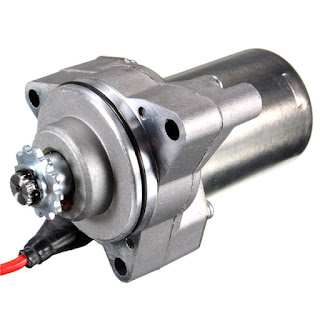From their early-’70s beginnings, electric starters are now everywhere. They’re a clever mix of magnets and coils that need proper maintenance…
What is it ?
Electric starters began to usurp kickstarts back in the early 1970s, first on big four-stroke roadsters and then gradually gaining ubiquity up until the present day, when pretty much the only place you’ll still find a kicker is on an off-road bike. The push-button convenience of electric starting comes at the cost of additional weight, not just from the motor but the bigger battery required to crank it and the higher output alternator needed to charge that.
These considerations kept the likes of two-strokes mostly electric boot-free, as well as their lower compression making them easier to kick over, but there eventually came a time in our convenience-driven world when even scooters succumbed to the ways of the button.
How It Works ?
A starter motor can be considered like a DC generator (dynamo), except that it works in reverse. Where a generator takes mechanical input and turns it into electrical output, a starter motor takes electrical input and turns it into mechanical output. Indeed, so close are the similarities that one can be run as the other, as evidenced by the combined starter-dynamos fitted to a few lightweight two-strokes of yore, such as the Yamaha RD200.
Working from the inside out, the starter motor has an armature at its centre. The armature is a shaft with a number of coils around it, with the commutator at one end. This consists of copper sections kept apart by insulators and it supplies electrical power to the armature windings, each commutator segment being connected to its opposite number on the other end through the armature coil they serve. The current is applied by two or four carbon / copper brushes, which are kept lightly in contact with the commutator segments by spring pressure.
Motors (like generators) need magnets in order to work, and in the starter motor these can be either permanent or field types. That means the body contains either permanent magnets or field coils that only provide a magnetic field when power is applied to the unit. The field coils are connected in series with the armature which gives this type of starter motor its name – the series motor.
The series motor is favoured for turning engines over as it can provide greater torque than the permanent magnet type. When you push the button and power is applied to the motor, a powerful magnetic field is induced by the current flowing through the field coils and this reacts with the power applied to the armature coil (or coils in a four-brush motor) via the brushes to push the armature around.
The result is low resistance from standstill to turn as the magnets only work once power is applied – unlike a permanent magnet type – plus high initial torque which is exactly what is required to turn over an engine from standstill. As the speed of the motor rises it creates its own power internally, known as back EMF (electromotive force), which reacts against the applied power. This has the effect of limiting the motor’s speed and stopping it spinning up uncontrollably.
To maximise the amount of torque available to turn the motor over, the armature’s output is geared down – typically by a ratio of around 14:1. This is usually achieved through a system of planetary gears in the end of the starter motor or a reduction gear following the unit.
Once the bike’s engine fires, the starter motor must disengage from the crankshaft to prevent damage. This is usually achieved with a roller clutch, which disengages when the engine fires and the speed of rotation of the crankshaft exceeds that of the starter motor. Some bikes use a sprag clutch containing pivoted eccentrics instead of rollers. These lock in one direction, as the starter motor is operated and released in the other direction when the engine fires.
The final type of engagement is the car-style pre-engaged starter found on Moto Guzzis and older BMWs. In this case a starter drive pinion is meshed with the flywheel through the movement of a solenoid-operated fork. The solenoid is mounted piggyback-style on the starter motor. As the solenoid’s plunger completes its movement it operates a switch, causing current to flow directly to the motor’s windings from the battery. Once the engine is running faster than the starter motor, the drive pinion is forced out of engagement down a spiral thread on the armature.
In Practice
Aside from the usual woes on older bikes occasioned by ageing wiring and connectors, plus poor battery charging leading to inadequate power supply to the starter motor, there are of course problems of wear and tear. Starter clutches, being mechanical, can and do wear – a situation often exacerbated by weak battery power and the clutch not being thrown into engagement as keenly as it should be.
A starter motor’s brushes can wear too, requiring their replacement, and the springs pushing them into contact with the commutator can also get lazy. As well as that the brushes can wear the commutator, although these can be machined down to a degree. The mica insulation in between the commutator’s segments will need to be undercut, too. Relays and solenoids don’t have an infinite life expectancy, either.
Reliable starting demands that everything is in good order, and that both electrical and mechanical systems are properly maintained – we’ll be doing a ‘How to’ on this in next article on RiderTips. Don’t ignore a whirring starter – it can cause damage elsewhere. In the absence of the back-up of a kickstarter, you’ll be glad you did.



